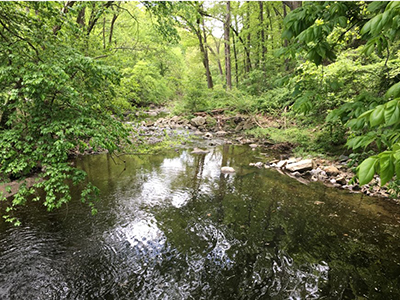Bacteria in our Waterways

Streams can be fun and exciting places to explore and understand nature, but all natural waters can contain algae, bacteria, viruses, and parasites. Bacteria are common single-celled organisms that occur in natural waters across the world. Most bacteria are harmless, but some can potentially cause Illnesses in humans and pets.
During heavy rainfall, pollution from the land washes into rivers, lakes, and streams. This pollution sometimes contains fecal indicator bacteria (FIB). These non-disease-causing bacteria come from warm-blooded animals (sometimes humans) and can multiply readily under the right conditions. High levels of these indicator bacteria do not necessarily mean the water is unsafe, but caution should be taken.
Potential Illnesses
The presence of E. coli and Enterococci bacteria (fecal indicator bacteria) can be an indication of fecal pollution, which may come from stormwater runoff, pets, wildlife, and human sewage. All natural bodies of water contain microscopic organisms including fecal bacteria and parasites that cause gastro-intestinal illness in people.
Escherichia coli (E. coli) and Enterococci bacteria normally live in the intestines of healthy people and warm-blooded animals. Most types of E. coli are harmless or cause minor illness, but a few strains can cause more severe symptoms. Most water-related illnesses are minor for people in good health. They typically require little or no treatment and have no long-term health effects.
When FIB bacteria levels exceed the established criteria, the risk of illness due to microorganism exposure increases. FIB also indicates potential exposure to other microbes including Giardia, Cryptosporidia, and other protozoa.
Common Illnesses
The most common health implications or illness associated with contaminated water include:
- gastroenteritis (nausea, vomiting, headache, stomachache, fever, and diarrhea)
- ear, nose, and throat infections
- rashes
- wound infections through an open cut or wound
Keep in mind that contaminants can find their way into all waterways, so there is always a risk for infections, especially for those who have chronic illnesses.
Stay Safe
To mitigate the public health threat, it is recommended that residents should:
- Avoid physical contact with the stream water
- Avoid wading in the water
- Keep pets out of the water
- Avoid drinking stream water or touching stream water
- Wash hands should physical contact occur and before eating
- Avoid water contacting an open cut, wound, or skin infection
- Pay attention and follow advisory signs
Warnings
A warning sign may be posted advising the public that the water may be unsafe for recreation such as swimming, wading, or skin contact. This includes pets! When they are posted, pay attention to warning signs—they will keep you and your pets safe and healthy.
Visit the Maryland Department of the Environment for
Maryland water quality standards.